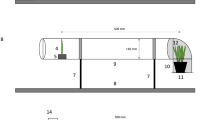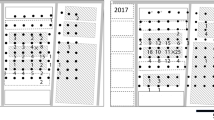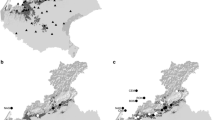Abstract
Sugarcane white leaf disease is a serious problem in many Asian Countries. The leafhoppers Matsumuratettix hiroglyphicus (Matsumura) and Yamatotettix flavovittatus Matsumura are the main vectors of sugarcane white leaf disease phytoplasma. Gaining a better understanding of the dispersal behavior of such insect vectors is essential for both disease epidemiology and vector control. The dispersal distances of M. hiroglyphicus and Y. flavovittatus in a sugarcane field were estimated by means of mark–release–recapture experiments. Adult leafhopper vectors collected from the fields were marked using fluorescent dye powder and released at a central release point in a sugarcane field. The marking method did not have a significant effect on the survival or flight activity of the leafhopper vectors. The overall release–recapture rates of M. hiroglyphicus and Y. flavovittatus within 50 m were 10.1 and 13.4 %, respectively. The estimated natural mean dispersal distances for M. hiroglyphicus and Y. flavovittatus were 162.1 and 387.5 m, respectively. Wind appears to be the main factor influencing the leafhopper dispersal direction.



Similar content being viewed by others
References
Blackmer JL, Hagler JR, Simmons GS, Canas LA (2004) Comparative dispersal of Homalodisca coagulate and Homalodisca liturata (Homoptera: Cicadellidae). Environ Entomol 33:88–99. doi:10.1603/0046-225X-33.1.88
Blackmer JL, Hagler JR, Simmons GS, Henneberry TJ (2006) Dispersal of Homalodisca vitripennis (Homoptera: Cicadellidae) from a point release site in citrus. Environ Entomol 35(6):1617–1625
Chen CT (1974) Sugarcane white leaf disease in Thailand and Taiwan. Sugarcane Pathologists’ Newsl 11(12):23
Darling ST (1925) Entomological research in malaria. South Med J 18:446–449
Hanboonsong Y (2008) The studies of ecology, behavior, efficiency of disease transmission of new insect vector of sugarcane white leaf disease and potential of its control (Sugarcane Project Report). Khon Kaen University, Khon Kaen (in Thai)
Hanboonsong Y, Choosai C, Panyim S, Damak S (2002) Transovarial transmission of sugarcane white leaf phytoplasma in the insect vector Matsumuratettix hiroglyphicus (Matsumura). Insect Mol Biol 11(1):97–103
Hanboonsong Y, Ritthison W, Choosai C, Sirithorn P (2006) Transmission of sugarcane white leaf phytoplasma by Yamatotettix flavovittatus, a new leafhopper vector. J Econ Entomol 99(5):1531–1537
Kobori Y, Nakata T, Ohto Y, Takasu F (2011) Dispersal of adult asian citrus psyllid, Diaphorina citri Kuwayama (Homoptera: Psyllidae), the vector of citrus greening disease, in artificial release experiments. Appl Entomol Zool 46:27–30. doi:10.1007/s13355-010-0004-z
Kumarasinghe NC, Jones P (2001) Identification of white leaf disease of sugarcane in Sri Lanka. Sugar Tech 3(1&2):55–58
Larsen KJ, Whalon ME (1988) Dispersal of Paraphlepsius irroratus (Say) (Homoptera: Cicadellidae) in peach and cherry orchards. Environ Entomol 17(5):842–851
Ling KC (1962) White leaf disease of sugarcane. Taiwan Sugar 9:1–5
Matsumoto T, Lee CS, Teng WS (1968) Studies on sugarcane white leaf disease of Taiwan with special reference to transmission by a leafhopper, Epitettix hiroglyphicus. Mats Pro Soc Sugarcane Tech 13:1090–1099
Nakashima K, Murata N (1993) Destructive plant disease caused by micoplasma-like organisms in Asia. Outlook Agric 22(1):53–58
Nakashima K, Wungkaew P, Sirithorn P (2001) Molecular detection and characterization of sugarcane white leaf phytoplasmas. In: Rao GP, Ford RE, Tosir M, Teakle TS (eds) Sugarcane pathology, vol II: virus and phytoplasma diseases. Science, Enfield, pp 157–175
Nakata T (2008) Effectiveness of micronized fluorescent powder for marking citrus psyllid, Diaphorina citri. Appl Entomol Zool 43:33–36. doi:10.1303/aez.2008.33
Phisitkul S, Kuntha C, Neera P, Wongkaew S, Chaihoi P, Chettharaj A (1989) Preliminary studies on insect vectors of sugarcane white leaf disease in Northeast Thailand. Khon Kaen Agric J 17:164–172
SAS Institute (2010) JMP 9 statistics and graphics guide. SAS Institute, Cary
Seber GAF (1982) The estimation of animal abundance and related parameters, 2nd edn. Charles Griffin, London
Taylor RAJ (1985) Migratory behaviour in the Auchenorrhyncha. In: Nault LR, Rodriguez JG (eds) The leafhoppers and planthoppers. Wiley, New York, pp 259–288
Thein MM, Jamjanya T, Hanboonsong Y (2011) Evaluation of color traps to monitor insect vectors of sugarcane white leaf phytoplasma. Bull Insectol 64(Suppl):117–118
Whitney SP, Meyer JR (1988) Movement between wild and cultivated blueberry by two species of sharpnosed leafhoppers (Homoptera: Cicadellidae) in North Carolina. J Entomol Sci 23:88–95
Yamamura K, Kishita M, Arakaki N, Kawamura F, Sadoyama Y (2003) Estimation of dispersal distance by mark-recapture experiments using traps: correction of bias caused by the artificial removal by traps. Popul Ecol 45:149–155. doi:10.1007/s10144-003-0152-x
Zhou L, Hoy CW, Miller SA, Nault LR (2003) Marking methods and field experiments to estimate aster leafhopper (Macrosteles quadrilineatus) dispersal rates. Environ Entomol 32(5):1177–1180
Acknowledgments
The authors are grateful for a Ph.D. scholarship funded by the Khon Kaen University—Khon Kaen University Scholarship for our Neighboring Country’s Personnel Program, and the sugarcane white leaf research fund from Khon Kaen University and Japan International Research Center for Agricultural Sciences.
Author information
Authors and Affiliations
Corresponding author
Appendix
Appendix
See Table 4
Rights and permissions
About this article
Cite this article
Thein, M.M., Jamjanya, T., Kobori, Y. et al. Dispersal of the leafhoppers Matsumuratettix hiroglyphicus and Yamatotettix flavovittatus (Homoptera: Cicadellidae), vectors of sugarcane white leaf disease. Appl Entomol Zool 47, 255–262 (2012). https://doi.org/10.1007/s13355-012-0117-7
Received:
Accepted:
Published:
Issue Date:
DOI: https://doi.org/10.1007/s13355-012-0117-7




